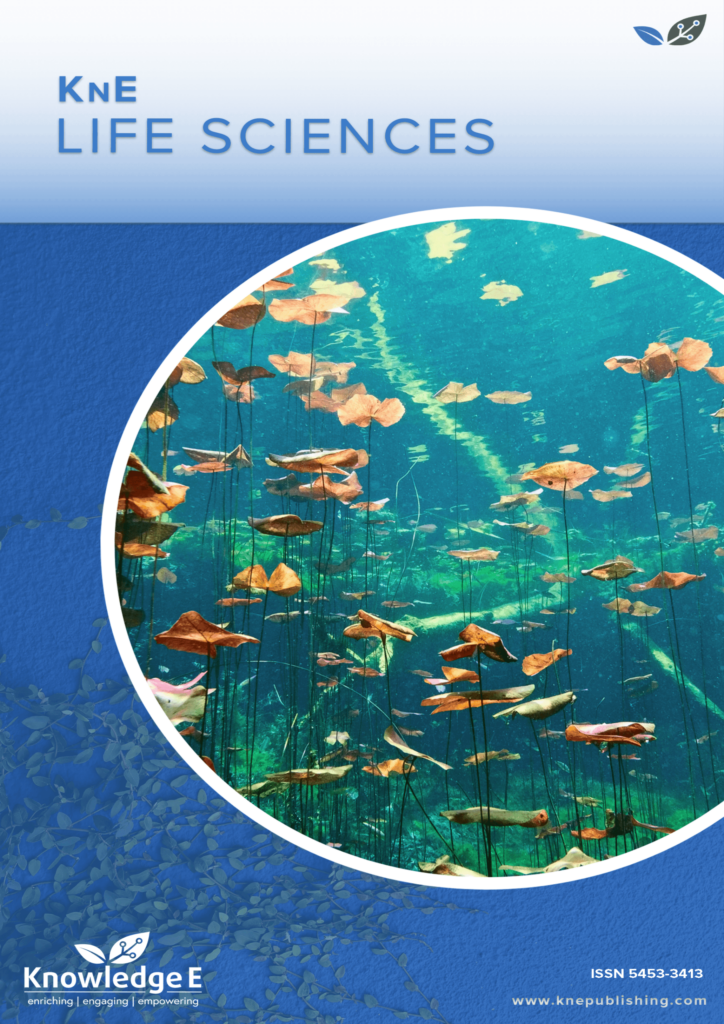
KnE Life Sciences
ISSN: 2413-0877
The latest conference proceedings on life sciences, medicine and pharmacology.
IDENTIFICATION OF ANTHRACHNOSE DISEASE ON STRAWBERRY FRUIT (Fragraria vesca L.) AND ITS CONTROL BY BETEL (Piper betle L.) LEAF EXTRACT
Published date: Sep 20 2015
Journal Title: KnE Life Sciences
Issue title: International Conference on Biological Sciences (ICBS-2013)
Pages: 458-465
Authors:
Abstract:
In Indonesia, strawberry is one of fruits which has high economic values. The growth of strawberry has increased significantly, but its productivity is still low because of disease attack. Disease that attacks strawberry started from nursery to post harvest is anthracnose that can be caused by Colletotrichum spp. Control efforts of anthracnose disease up to now has been done with application of synthetic chemicals which are known to be hazardous to the environment and human health. Betel leaf (Piper betle L.) is natural plant that potentially used as phytofungicide. Essential oils on betel leaf extract is reported can decrease the growth of pathogenic fungi. The objectives of the research were to identify Colletotrichum spp. in strawberry fruit that showed anthracnose symptoms, to test the potency of betel leaf extract as phytofungicide, and to evaluate the effect of betel leaf extract in inhibiting infection and disease severity of Colletotrichum in strawberry. Samples were taken from strawberry nursery in Magelang, Indonesia. The disease symptoms were isolated on Potato Dextrose Agar, followed by identification of fungal colony and morphology by semi permanent slide preparation. Betel leaves were extracted with water to get a concentration of 20, 40, 60, 80 and 100%, respectively. An in vitro experiment was done to evaluate the inhibition rate of betel leaf extract to the growth of Colletotrichum spp. colony. An in vivo experiment was done by submersion of strawberry to betel leaf extract before (preventive method) and after antrachnose attack (curative method), then disease infection and disease severity were measured after 7 days. The result of the research showed that anthracnose disease in strawberry was caused by C. gloeosporioides (Penz.). Twenty percent of betel leaf extract in an in vitro test had potential as phytofungicide and concentration of 100% betel leaf extract was the best concentration to inhibit the growth of C. gloeosporioides (Penz.) colony by 70.26±0,61%. In an in vivo experiment, submersion of strawberry before pathogen infection (preventive) with 100% betel leaf extract decreased disease infection by 40% and disease severity by 16%, respectively. While treatment of submersion of strawberry after pathogen infection (curative) decreased disease infection by 33,4% and disease severity by 17%.
Keywords: strawberry, anthrachnose, disease, betel leaf
References:
Camadioha, A. 1999. Evaluation of some plant leaf extracts against Colletotrichum lindemuthianum in cowpea. Arch.Phytopath.Pflanz, 32: 141-149.
Central Bureau of Statistics. 2011. Several developments Main Socio-Economic Indicators of Indonesia. http://www.bps.go.id, accessed 11 November 2012.
Chang, M.C., B.J. Uang, H.L. Wu, J.J. Lee, and J.H. Jeng. 2002. A major phenolic compound in Piper betle leaves. Br. J. Pharmacol. 135: 619-630.
Dasgupta, N., and B. De. 2004. Antioxidant activity of Piper betle L. leaf extract in vitro. Food Chem., 88: 219-224.
Debode J., W. Baeyen, S. Van Hemelrijck, P. Creemers, K. Heungens, and M. Maes. 2009. Quantitative detection and monitoring of Colletotrichum acutatum in strawberry leaves using real-time PCR. Plant. Pathol. 58:504–514.
Debode J., W. Van Hemelrijck, P. Creemers, and M. Maes. 2013. Effect of fungicides on epiphytic yeasts associated with strawberry. Microbiology open, 2 (3): 482-491.
Gandjar I., W. Sjamsuridzal, and A. Oetari. 2006. Basic and Applied Mycology. Yayasan Obor Indonesia. Jakarta, pp. 3-4.
Guidarelli M., F. Carbone, F. Mourgues, G. Perrotta, C. Rosati, and P. Bertolini. 2011. Colletotrichum acutatum interactions with unripe and ripe strawberry fruits and differential responses at histological and transcriptional levels. Plant. Pathol., 60:685–697.
Jesonbabu, J., N. Spandana, and K.A. Lakshmi. 2012. In vitro antimicrobial potentialities of chloroform extracts of Ethanomedicinal plant against clinically isolated human pathogens. Int. J. Pharm. Pharm. Sci. 4 (3): 624-626.
Johnny, L., U.Y. Yusuf, and R. Nulit. 2011. Antifungal activity of selected plant leaves crude extracts against a pepper anthracnose fungus, Colletotrichum capsici (Sydow) butler and bisby (Ascomycota: Phyllachorales). African Journal of Biotechnology, 10 (20): 4157-4165
Kim, J., M.R. Marshall, and C. Wei. 1995. Antibacterial activity of some essential oil component against five foodborne pathogens. J. Agric Food Chem., 43 (11): 28392845.
Kubo, A., C.S. Lunde, and I. Kubo. 1995. Antimicrobial activity of the olive oil flavor compounds. Journal of Agricultural. Food Chemistry. 43: 1629-1633.
Lubbe, C. M., S. Denman, P.F. Cannon, J.Z. Groenewald, and P.W. Crous. 2004. Characterization of Colletotrichum species associated with diseases of Proteaceae. Mycologia 96 (6):1273.
Marhaenis, E. 2011. Potential of Watercress Extract (Ipomea aquatica Forsk.) As Biofungisida for Disease Control of Fusarium Fruit Rot in Tomato Fruit. Thesis. Faculty of Agriculture. Bogor Agricultural Institute.
Mertely, J.C., N.A. Peres, and C.K. Chandler. 2007. Anthracnose Fruit Rot of Strawberry. http://edis.ifas.ufl.edupdffilesPPPP13000.pdf, accessed 2 Mei 2012.
Ramji, N., R. Iyer, and S. Chandrasekaran. 2002. Phenolic antibacterials from Piper betle in the prevention of halitosis. J.Ethnopharm., 83: 149-152.
Rimando, A.M. 1986. Studies on the constituents of Philippines P.betle leaves. Arch. Pharmacol. Res., 9: 93-97.
Sharma, S., I. Ali Khan, I. Ali, F. Ali, M. Kumar, A. Kumar, R.K. Johri, S.T. Abdullah, S. Bani, A. Pandey, K.A. Suri, B.D. Gupta, N.K. Satti, P. Dutt, and G.N. Qazi. 2009. Evaluation of the antimicrobial, antioxidant and antiinflammatory activities of hydroxychavicol for its potential use as an oral care agent. Antimicrob. Agents Chemother., 53 (1): 216-222.
Srichana, D., A. Phumruang, and B. Chongkid. 2009. Inhibition effect of betel leaf extract on the growth of Aspergillus flavus and Fusarium verticillioides. Thammasat Int. J. Sc. Tech, 14 (3): 74-77.
